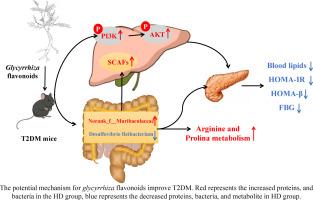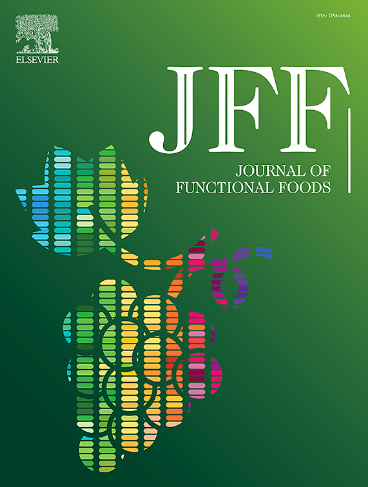甘草黄酮通过微生物-肠-肝轴改善高血糖inT2DM小鼠
IF 4
2区 农林科学
Q2 FOOD SCIENCE & TECHNOLOGY
引用次数: 0
摘要
甘草(glycyrhiza uralensis Fisch)通常被用作糖果、饮料和草药茶中的天然调味剂。其活性成分,如甘草酸和黄酮类化合物,具有抗氧化和抗炎作用。然而,它对2型糖尿病的潜在影响尚不清楚。本研究旨在探讨甘草黄酮对小鼠2型糖尿病(T2DM)的保护作用,并探讨其分子机制。STZ注射液联合高脂饮食(HFD)建立T2DM小鼠模型。用不同浓度的甘草黄酮治疗T2DM小鼠5周。我们观察到,甘草黄酮可显著改善高血糖、高脂血症、胰岛素抵抗以及肝脏和结肠组织的病理损伤,激活PI3K/AKT通路。甘草黄酮还能提高肝脏中戊酸、4-甲基戊酸、己酸等短链脂肪酸(SCFAs)的水平。在属水平上,甘草黄酮也降低了肠道中回肠杆菌的丰度。此外,甘草黄酮还能调节肠道中色氨酸和精氨酸的代谢。综上所述,甘草黄酮通过调节PI3K/AKT信号通路、肠道菌群组成和肝脏SCFAs生成来改善T2DM的代谢结局。这些发现放大了甘草黄酮的机制及其减轻胰岛素抵抗的潜力。本文章由计算机程序翻译,如有差异,请以英文原文为准。

Glycyrrhiza flavonoids improves hyperglycemia inT2DM mice by microbial-gut-liver axis
Licorice (Glycyrrhiza uralensis Fisch) is commonly used as a natural flavoring agent in candies, beverages, and herbal teas. Its active compounds, such as glycyrrhizin and flavonoids, exhibit antioxidant and anti-inflammatory effects. However, its potential effects on type 2 diabetes remain unclear. The present study aimed to investigate the protective effects of glycyrrhiza flavonoids against type 2 diabetes mellitus (T2DM) in mice and explore the underlying molecular mechanisms. STZ injection and high-fat diet (HFD) combined to establish T2DM mouse model. T2DM mice were treated with different concentrations of glycyrrhiza flavonoids for 5 weeks. We observe that Glycyrrhiza flavonoids significantly ameliorated hyperglycemia, hyperlipidemia, insulin resistance, and pathological damage in liver and colonic tissues, activated the PI3K/AKT pathway. Glycyrrhiza flavonoids also increase the level of short chain fatty acids (SCFAs) such as Valeric acid, 4-Methylvaleric acid, Caproic acid in liver. Glycyrrhiza flavonoids also reduced the abundance of Ileibacterium in the gut at the genus level. In addition, glycyrrhiza flavonoids modulates the metabolisms of tryptophan and arginine in gut. In conclude, Glycyrrhiza flavonoids improve metabolic outcomes in T2DM by modulating PI3K/AKT signaling pathway, gut microbiota composition and SCFAs production in liver. These findings amplified the mechanisms of Glycyrrhiza flavonoids and its potential to attenuate insulin resistance.
求助全文
通过发布文献求助,成功后即可免费获取论文全文。
去求助
来源期刊

Journal of Functional Foods
FOOD SCIENCE & TECHNOLOGY-
CiteScore
9.60
自引率
1.80%
发文量
428
审稿时长
76 days
期刊介绍:
Journal of Functional Foods continues with the same aims and scope, editorial team, submission system and rigorous peer review. We give authors the possibility to publish their top-quality papers in a well-established leading journal in the food and nutrition fields. The Journal will keep its rigorous criteria to screen high impact research addressing relevant scientific topics and performed by sound methodologies.
The Journal of Functional Foods aims to bring together the results of fundamental and applied research into healthy foods and biologically active food ingredients.
The Journal is centered in the specific area at the boundaries among food technology, nutrition and health welcoming papers having a good interdisciplinary approach. The Journal will cover the fields of plant bioactives; dietary fibre, probiotics; functional lipids; bioactive peptides; vitamins, minerals and botanicals and other dietary supplements. Nutritional and technological aspects related to the development of functional foods and beverages are of core interest to the journal. Experimental works dealing with food digestion, bioavailability of food bioactives and on the mechanisms by which foods and their components are able to modulate physiological parameters connected with disease prevention are of particular interest as well as those dealing with personalized nutrition and nutritional needs in pathological subjects.
 求助内容:
求助内容: 应助结果提醒方式:
应助结果提醒方式:


